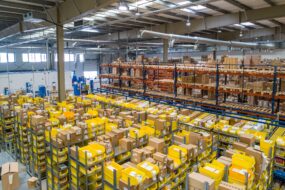Contents

Inventory is one of the most crucial assets of an e-commerce business. It is vital to have a system in place to help monitor and manage it.
A perpetual inventory system can provide a reliable and accurate tracking of your inventory to ensure that you can keep up with demand while helping to avoid overstocking and expensive and unnecessary storage fees. Perpetual inventory systems work in real time to ensure that you always know the status of your inventory.
What Is a Perpetual Inventory System?
A perpetual inventory system tracks inventory in real time by recording all inventory changes with each transaction. This will let you know when your stock is low, when it sells out, and when new stock is received. A perpetual inventory system automates inventory tracking and monitoring.
How Perpetual Inventory Systems Work
Perpetual inventory systems monitor your stock based on electronic records by continuously tracking as goods are bought and sold. A perpetual inventory system can provide a reliable and efficient way to monitor and manage your stock by following this flow:
- Physical count of inventory is made to create the baseline.
- Inventory level is updated as products are bought and sold. The inventory management system attached to the POS (point of sale) subtracts the sold product from the total inventory as soon as a sale is made. RFID (radio-frequency identification) or barcode scanners can simplify and streamline this process.
- Cost of goods sold (COGS) is recalculated automatically every time a product is bought or sold.
- As sales increase and decrease, reorder points are automatically updated to ensure that you have the correct amount of inventory on hand at all times.
- Purchase orders are automatically generated as soon as a product, or specific SKU, hits the reorder point, and this is sent directly to your supplier.
- When new inventory is received at your warehouse, an employee will scan the product using a WMS (warehouse management system), and the product will then appear in your inventory management dashboard to be available in your desired sales channels.
Benefits of a Perpetual Inventory System
Perpetual inventory systems are reliable and efficient. They can directly impact your bottom line by helping to save you time and money and ensuring that you have an accurate count of your inventory at all times. These are some of the key advantages of a perpetual inventory system:
- Real-time tracking of data: Inventory is updated as soon as changes are made, such as when product goes out or comes in
- Lowers labor costs and reduces human error: Many of the inventory management processes are automated, cutting out the need for human interaction and the potential for incorrect data entry.
- Optimizes the e-commerce supply chain: The movement of inventory is tracked throughout the entire supply chain so you can see potential issues, such as bottlenecks, in your procedures.
- Simplifies forecast demand: Sales data and historical inventory trends can be used to better predict sales trends and account for seasonality.
- End-of-year inventory balance is calculated automatically: This simplifies the end-of-year accounting processes.
Perpetual Inventory System vs. Periodic Inventory System
A perpetual inventory system is more advanced, reliable, and accurate than a periodic inventory system. While a perpetual inventory system tracks your inventory in real time and centralizes the inventory data, a periodic inventory system physically counts inventory at specific intervals, such as at the end of a financial year or accounting period. The periodic inventory system uses inventory valuation methods, including weighted averages, FIFO (first in, first out), and LIFO (last in, first out) to calculate COGS.
Both the perpetual inventory system and the periodic inventory system are used to track available products, but the periodic inventory system has a greater margin of error since it is not constantly tracking inventory. Instead, it only tracks inventory at scheduled times.
Perpetual Inventory Method Formulas
There are several different formulas that can be used to keep track of physical inventory counts, including EOQ (economic order quantity), weighted average cost, FIFO, LIFO, and finished goods.
EOQ
This formula is designed to find the ideal order quantity while minimizing stockouts and costs. The formula is as follows:
EOQ = square root of [2S(set up costs)D(demand rate0]/H(holding costs)
Weighted Average Cost
An accounting system that determines how much money is spent on COGS and inventory using a weighted average. The formula is as follows:
Weighted average cost = cost of goods available for sale/total number of units in inventory
FIFO
This system sells the goods purchased first before selling goods purchased later, meaning that customers will receive older inventory first before newer inventory. Assets with the oldest costs are then used to calculate COGS.
LIFO
This inventory valuation method sells the more recently purchased goods before older inventory. The most recent assets acquired are used to calculate COGS.
Finished Goods
Sellers can calculate inventory cost with this formula that refers to the stock available for purchase by subtracting the cost of goods sold (COGS) from the cost of goods manufactured (COGM). The formula is as follows:
Finished goods = (COGM – COGS) + value of previous year’s finished goods
Optimizing Inventory Management
E-commerce businesses are often fast-paced and can grow quickly. To keep up with order demand and ensure customer satisfaction through order fulfillment, you need a reliable and accurate inventory management system. A perpetual inventory management system can help you to keep an accurate record of exactly how much inventory you have at any given time. It will also help to find any inefficiencies in your inventory supply chain and correct them.
A perpetual inventory management can also help you to scale inventory up and down as your business needs, helping to keep warehouse costs as low as possible while ensuring you have the optimal amount of inventory needed to fulfill orders. You can outsource order fulfillment to 3PLs (third party logistics), and they can aid in the inventory management process.
References
Periodic Inventory vs. Perpetual Inventory: What’s the Difference? (July 2021). Investopedia.
Five Ways To Improve Your Inventory Management. (October 2018). Forbes.




